Business Communication: Intercultural Aspects in Organizations
VerifiedAdded on 2022/11/26
|8
|1645
|392
Report
AI Summary
This report provides a comprehensive overview of intercultural communication within a business context. It begins by defining communication's significance in organizations and explores barriers to effective intercultural exchange. The report then delves into the intricate relationship between language and culture, emphasizing their impact on workplace dynamics. It further examines Edgar Schein's three levels of organizational culture (artefacts, espoused values, and basic underlying assumptions) and their influence on business operations. The core of the report focuses on cultural differences and diversity in the workplace, highlighting the importance of understanding and managing these aspects to foster collaboration and enhance organizational performance. The report concludes by underscoring the vital role of organizational culture and communication in achieving long-term business success, emphasizing the need for managers to prioritize these elements.

Running Head: MANAGEMENT
0
Business Communication
5/16/2019
0
Business Communication
5/16/2019
Paraphrase This Document
Need a fresh take? Get an instant paraphrase of this document with our AI Paraphraser

MANAGEMENT
1
Contents
Introduction...................................................................................................................2
Three levels of culture (Edgar Schein).........................................................................2
Relationship between language and culture................................................................3
Intercultural communication..........................................................................................3
Cultural differences and diversity in workplace............................................................3
Conclusion....................................................................................................................4
References...................................................................................................................6
1
Contents
Introduction...................................................................................................................2
Three levels of culture (Edgar Schein).........................................................................2
Relationship between language and culture................................................................3
Intercultural communication..........................................................................................3
Cultural differences and diversity in workplace............................................................3
Conclusion....................................................................................................................4
References...................................................................................................................6
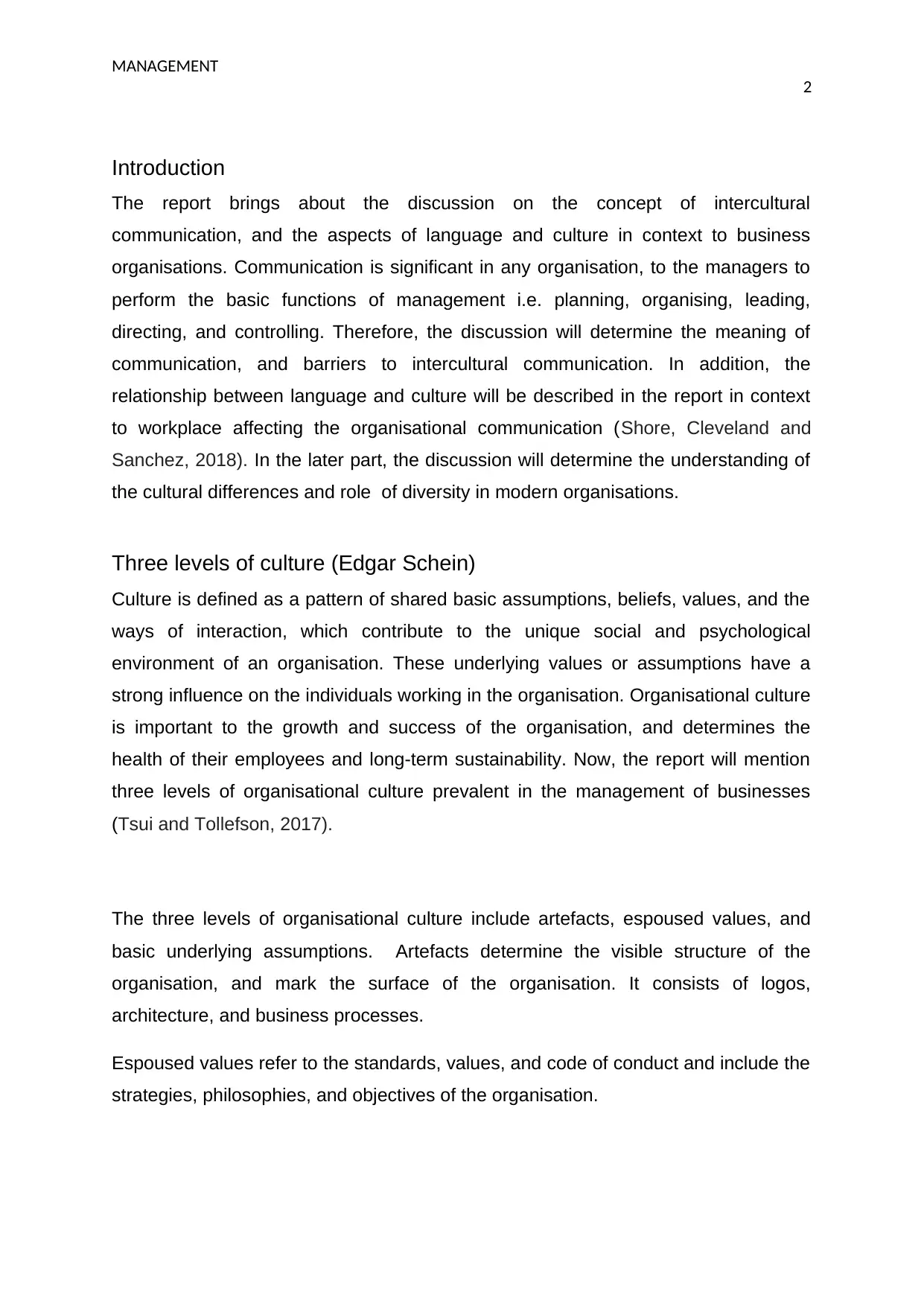
MANAGEMENT
2
Introduction
The report brings about the discussion on the concept of intercultural
communication, and the aspects of language and culture in context to business
organisations. Communication is significant in any organisation, to the managers to
perform the basic functions of management i.e. planning, organising, leading,
directing, and controlling. Therefore, the discussion will determine the meaning of
communication, and barriers to intercultural communication. In addition, the
relationship between language and culture will be described in the report in context
to workplace affecting the organisational communication (Shore, Cleveland and
Sanchez, 2018). In the later part, the discussion will determine the understanding of
the cultural differences and role of diversity in modern organisations.
Three levels of culture (Edgar Schein)
Culture is defined as a pattern of shared basic assumptions, beliefs, values, and the
ways of interaction, which contribute to the unique social and psychological
environment of an organisation. These underlying values or assumptions have a
strong influence on the individuals working in the organisation. Organisational culture
is important to the growth and success of the organisation, and determines the
health of their employees and long-term sustainability. Now, the report will mention
three levels of organisational culture prevalent in the management of businesses
(Tsui and Tollefson, 2017).
The three levels of organisational culture include artefacts, espoused values, and
basic underlying assumptions. Artefacts determine the visible structure of the
organisation, and mark the surface of the organisation. It consists of logos,
architecture, and business processes.
Espoused values refer to the standards, values, and code of conduct and include the
strategies, philosophies, and objectives of the organisation.
2
Introduction
The report brings about the discussion on the concept of intercultural
communication, and the aspects of language and culture in context to business
organisations. Communication is significant in any organisation, to the managers to
perform the basic functions of management i.e. planning, organising, leading,
directing, and controlling. Therefore, the discussion will determine the meaning of
communication, and barriers to intercultural communication. In addition, the
relationship between language and culture will be described in the report in context
to workplace affecting the organisational communication (Shore, Cleveland and
Sanchez, 2018). In the later part, the discussion will determine the understanding of
the cultural differences and role of diversity in modern organisations.
Three levels of culture (Edgar Schein)
Culture is defined as a pattern of shared basic assumptions, beliefs, values, and the
ways of interaction, which contribute to the unique social and psychological
environment of an organisation. These underlying values or assumptions have a
strong influence on the individuals working in the organisation. Organisational culture
is important to the growth and success of the organisation, and determines the
health of their employees and long-term sustainability. Now, the report will mention
three levels of organisational culture prevalent in the management of businesses
(Tsui and Tollefson, 2017).
The three levels of organisational culture include artefacts, espoused values, and
basic underlying assumptions. Artefacts determine the visible structure of the
organisation, and mark the surface of the organisation. It consists of logos,
architecture, and business processes.
Espoused values refer to the standards, values, and code of conduct and include the
strategies, philosophies, and objectives of the organisation.
⊘ This is a preview!⊘
Do you want full access?
Subscribe today to unlock all pages.

Trusted by 1+ million students worldwide
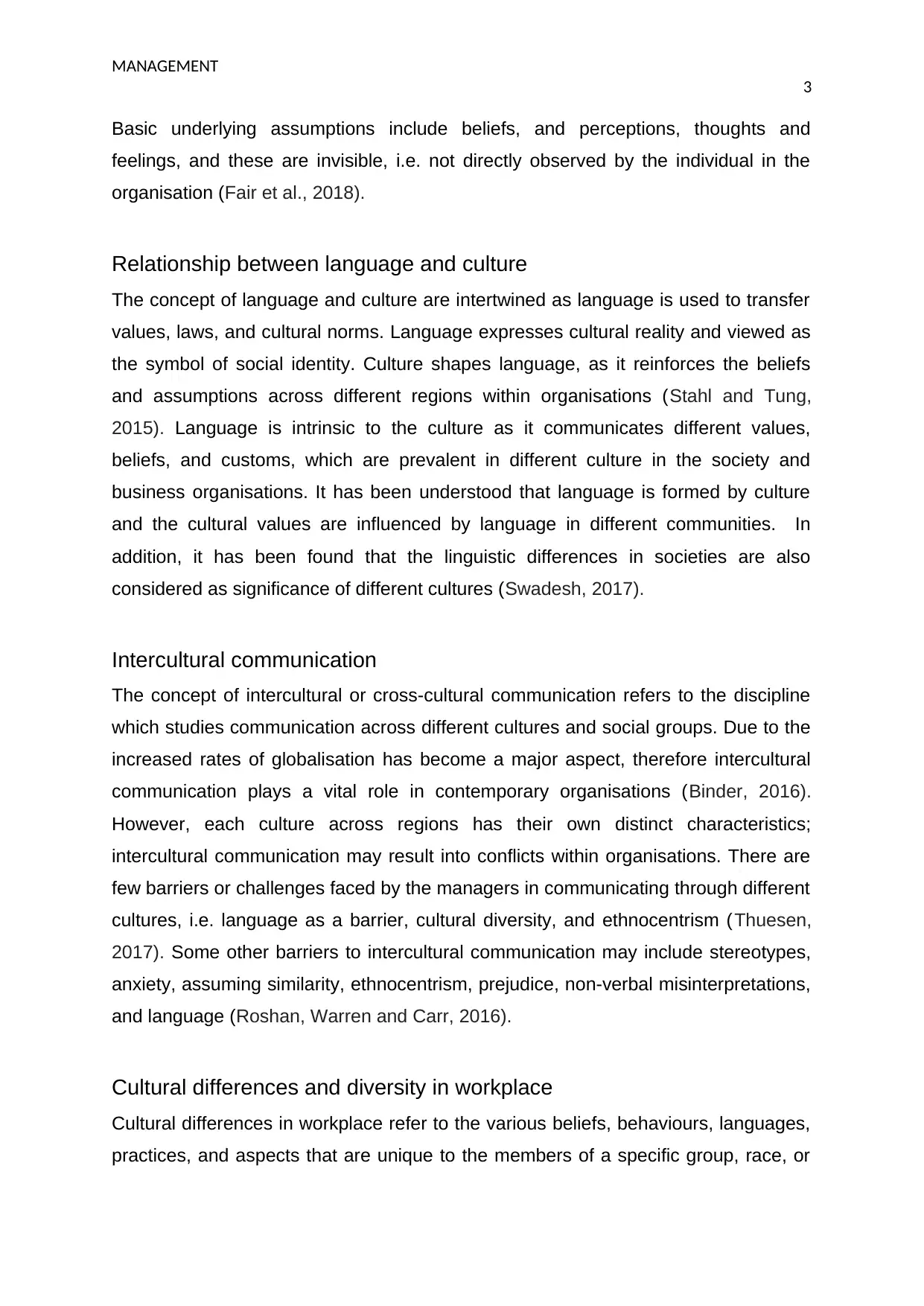
MANAGEMENT
3
Basic underlying assumptions include beliefs, and perceptions, thoughts and
feelings, and these are invisible, i.e. not directly observed by the individual in the
organisation (Fair et al., 2018).
Relationship between language and culture
The concept of language and culture are intertwined as language is used to transfer
values, laws, and cultural norms. Language expresses cultural reality and viewed as
the symbol of social identity. Culture shapes language, as it reinforces the beliefs
and assumptions across different regions within organisations (Stahl and Tung,
2015). Language is intrinsic to the culture as it communicates different values,
beliefs, and customs, which are prevalent in different culture in the society and
business organisations. It has been understood that language is formed by culture
and the cultural values are influenced by language in different communities. In
addition, it has been found that the linguistic differences in societies are also
considered as significance of different cultures (Swadesh, 2017).
Intercultural communication
The concept of intercultural or cross-cultural communication refers to the discipline
which studies communication across different cultures and social groups. Due to the
increased rates of globalisation has become a major aspect, therefore intercultural
communication plays a vital role in contemporary organisations (Binder, 2016).
However, each culture across regions has their own distinct characteristics;
intercultural communication may result into conflicts within organisations. There are
few barriers or challenges faced by the managers in communicating through different
cultures, i.e. language as a barrier, cultural diversity, and ethnocentrism (Thuesen,
2017). Some other barriers to intercultural communication may include stereotypes,
anxiety, assuming similarity, ethnocentrism, prejudice, non-verbal misinterpretations,
and language (Roshan, Warren and Carr, 2016).
Cultural differences and diversity in workplace
Cultural differences in workplace refer to the various beliefs, behaviours, languages,
practices, and aspects that are unique to the members of a specific group, race, or
3
Basic underlying assumptions include beliefs, and perceptions, thoughts and
feelings, and these are invisible, i.e. not directly observed by the individual in the
organisation (Fair et al., 2018).
Relationship between language and culture
The concept of language and culture are intertwined as language is used to transfer
values, laws, and cultural norms. Language expresses cultural reality and viewed as
the symbol of social identity. Culture shapes language, as it reinforces the beliefs
and assumptions across different regions within organisations (Stahl and Tung,
2015). Language is intrinsic to the culture as it communicates different values,
beliefs, and customs, which are prevalent in different culture in the society and
business organisations. It has been understood that language is formed by culture
and the cultural values are influenced by language in different communities. In
addition, it has been found that the linguistic differences in societies are also
considered as significance of different cultures (Swadesh, 2017).
Intercultural communication
The concept of intercultural or cross-cultural communication refers to the discipline
which studies communication across different cultures and social groups. Due to the
increased rates of globalisation has become a major aspect, therefore intercultural
communication plays a vital role in contemporary organisations (Binder, 2016).
However, each culture across regions has their own distinct characteristics;
intercultural communication may result into conflicts within organisations. There are
few barriers or challenges faced by the managers in communicating through different
cultures, i.e. language as a barrier, cultural diversity, and ethnocentrism (Thuesen,
2017). Some other barriers to intercultural communication may include stereotypes,
anxiety, assuming similarity, ethnocentrism, prejudice, non-verbal misinterpretations,
and language (Roshan, Warren and Carr, 2016).
Cultural differences and diversity in workplace
Cultural differences in workplace refer to the various beliefs, behaviours, languages,
practices, and aspects that are unique to the members of a specific group, race, or
Paraphrase This Document
Need a fresh take? Get an instant paraphrase of this document with our AI Paraphraser

MANAGEMENT
4
national origin. National origin and ethnicity is considered to be the most common
and influential cultural difference in organisations. Here, language and culture of
businesses and the method or styles of working differs from one business
organisation to other (Ladegaard and Jenks, 2015).
Understanding cultural differences is important in the business organisations in order
to facilitate the coordination and collaboration of work practices. Moreover, it is
important to assist employees in their work as culture influence business, as it
influences the management of employees based on their values and priorities.
Factors that contribute to cultural differences and cultural diversity are differences
attributed to the work styles, education, and disability. Therefore, the concept of the
cultural differences has contributed to the aspect or element of diversity at workplace
(Guillaume et al., 2017).
Diversity at the workplace is important for employees because an organisation
manifest the aspect of great reputation for the company, which leads to the
enhanced profitability. Cultural diversity is defined as the aspect of appreciating the
differences in culture or individuals working in an organisation. It is practiced by
managers in organisations when they hire individuals from different cultural
backgrounds, regardless of their religion, race, and culture.
One of the major benefits of the cultural diversity at workplace involves creativity, i.e.
within teams and the availability of a diverse set of solutions. Number of positive
benefits of cultural diversity at workplace, involves advantages to both, i.e. the
employees and the companies. Increased productivity, creativity, teamwork, higher
levels of employee engagement, reduced employee turnover, increased company
reputation, and better organisational culture, are some of the benefits (Cloutier et al.,
2015). From the research, it has been also analysed that the element of cultural
diversity in workplace, employee work in coordination and respect each other which
further increases their morale to work with high commitment. High level of employee
engagement and commitment to work ensures customer satisfaction in the long term
(Swadesh, 2017).
4
national origin. National origin and ethnicity is considered to be the most common
and influential cultural difference in organisations. Here, language and culture of
businesses and the method or styles of working differs from one business
organisation to other (Ladegaard and Jenks, 2015).
Understanding cultural differences is important in the business organisations in order
to facilitate the coordination and collaboration of work practices. Moreover, it is
important to assist employees in their work as culture influence business, as it
influences the management of employees based on their values and priorities.
Factors that contribute to cultural differences and cultural diversity are differences
attributed to the work styles, education, and disability. Therefore, the concept of the
cultural differences has contributed to the aspect or element of diversity at workplace
(Guillaume et al., 2017).
Diversity at the workplace is important for employees because an organisation
manifest the aspect of great reputation for the company, which leads to the
enhanced profitability. Cultural diversity is defined as the aspect of appreciating the
differences in culture or individuals working in an organisation. It is practiced by
managers in organisations when they hire individuals from different cultural
backgrounds, regardless of their religion, race, and culture.
One of the major benefits of the cultural diversity at workplace involves creativity, i.e.
within teams and the availability of a diverse set of solutions. Number of positive
benefits of cultural diversity at workplace, involves advantages to both, i.e. the
employees and the companies. Increased productivity, creativity, teamwork, higher
levels of employee engagement, reduced employee turnover, increased company
reputation, and better organisational culture, are some of the benefits (Cloutier et al.,
2015). From the research, it has been also analysed that the element of cultural
diversity in workplace, employee work in coordination and respect each other which
further increases their morale to work with high commitment. High level of employee
engagement and commitment to work ensures customer satisfaction in the long term
(Swadesh, 2017).
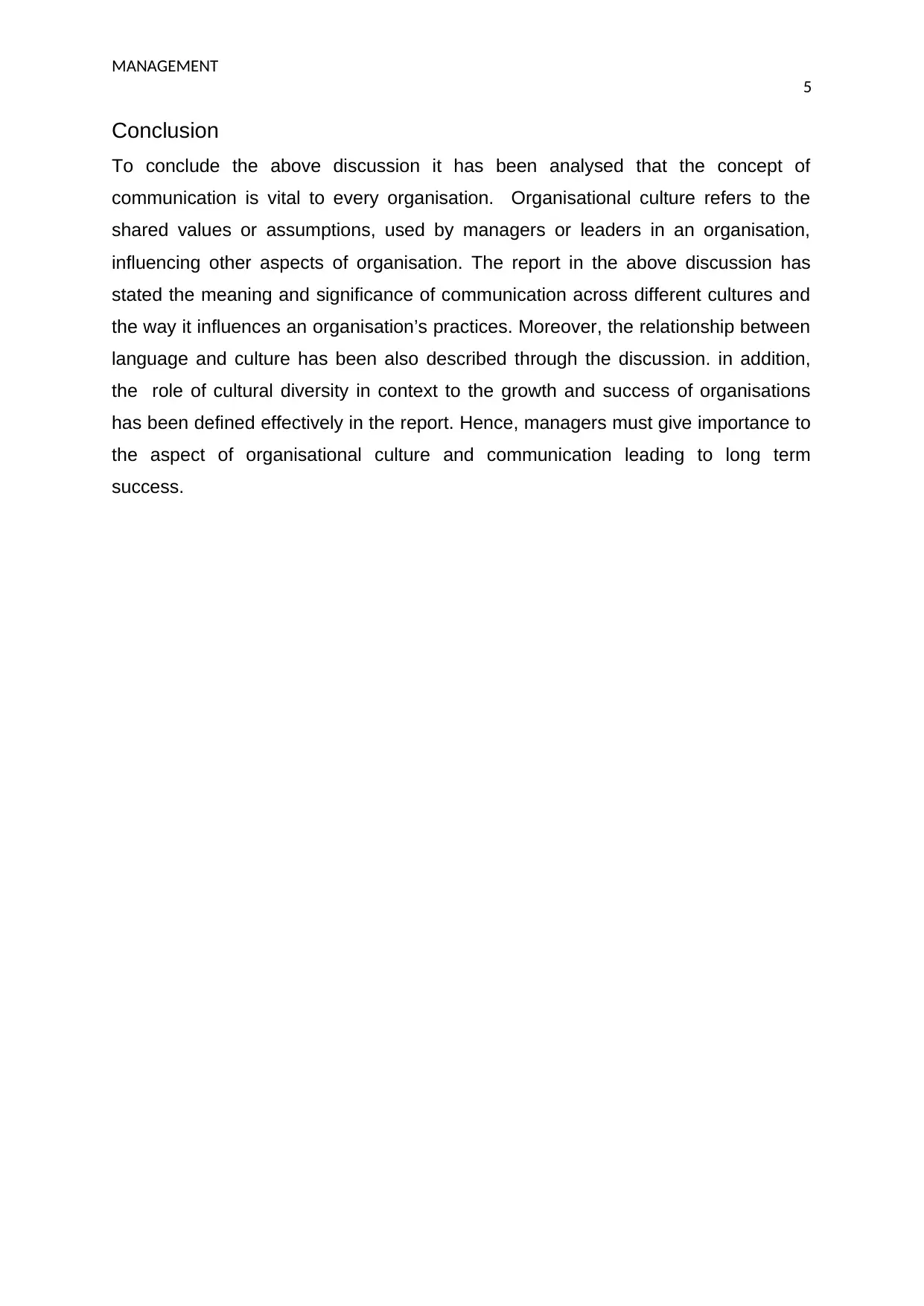
MANAGEMENT
5
Conclusion
To conclude the above discussion it has been analysed that the concept of
communication is vital to every organisation. Organisational culture refers to the
shared values or assumptions, used by managers or leaders in an organisation,
influencing other aspects of organisation. The report in the above discussion has
stated the meaning and significance of communication across different cultures and
the way it influences an organisation’s practices. Moreover, the relationship between
language and culture has been also described through the discussion. in addition,
the role of cultural diversity in context to the growth and success of organisations
has been defined effectively in the report. Hence, managers must give importance to
the aspect of organisational culture and communication leading to long term
success.
5
Conclusion
To conclude the above discussion it has been analysed that the concept of
communication is vital to every organisation. Organisational culture refers to the
shared values or assumptions, used by managers or leaders in an organisation,
influencing other aspects of organisation. The report in the above discussion has
stated the meaning and significance of communication across different cultures and
the way it influences an organisation’s practices. Moreover, the relationship between
language and culture has been also described through the discussion. in addition,
the role of cultural diversity in context to the growth and success of organisations
has been defined effectively in the report. Hence, managers must give importance to
the aspect of organisational culture and communication leading to long term
success.
⊘ This is a preview!⊘
Do you want full access?
Subscribe today to unlock all pages.

Trusted by 1+ million students worldwide
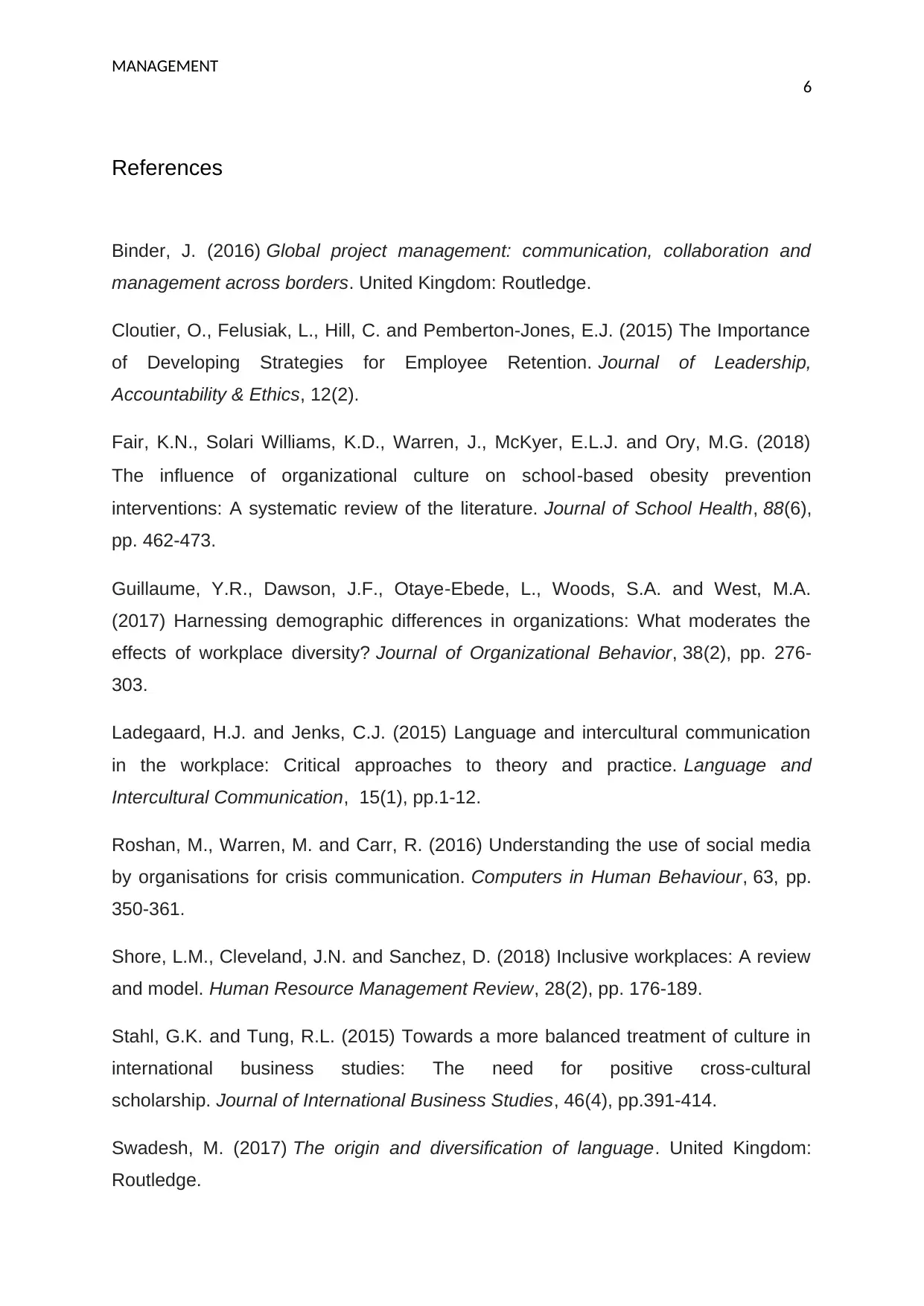
MANAGEMENT
6
References
Binder, J. (2016) Global project management: communication, collaboration and
management across borders. United Kingdom: Routledge.
Cloutier, O., Felusiak, L., Hill, C. and Pemberton-Jones, E.J. (2015) The Importance
of Developing Strategies for Employee Retention. Journal of Leadership,
Accountability & Ethics, 12(2).
Fair, K.N., Solari Williams, K.D., Warren, J., McKyer, E.L.J. and Ory, M.G. (2018)
The influence of organizational culture on school‐based obesity prevention
interventions: A systematic review of the literature. Journal of School Health, 88(6),
pp. 462-473.
Guillaume, Y.R., Dawson, J.F., Otaye‐Ebede, L., Woods, S.A. and West, M.A.
(2017) Harnessing demographic differences in organizations: What moderates the
effects of workplace diversity? Journal of Organizational Behavior, 38(2), pp. 276-
303.
Ladegaard, H.J. and Jenks, C.J. (2015) Language and intercultural communication
in the workplace: Critical approaches to theory and practice. Language and
Intercultural Communication, 15(1), pp.1-12.
Roshan, M., Warren, M. and Carr, R. (2016) Understanding the use of social media
by organisations for crisis communication. Computers in Human Behaviour, 63, pp.
350-361.
Shore, L.M., Cleveland, J.N. and Sanchez, D. (2018) Inclusive workplaces: A review
and model. Human Resource Management Review, 28(2), pp. 176-189.
Stahl, G.K. and Tung, R.L. (2015) Towards a more balanced treatment of culture in
international business studies: The need for positive cross-cultural
scholarship. Journal of International Business Studies, 46(4), pp.391-414.
Swadesh, M. (2017) The origin and diversification of language. United Kingdom:
Routledge.
6
References
Binder, J. (2016) Global project management: communication, collaboration and
management across borders. United Kingdom: Routledge.
Cloutier, O., Felusiak, L., Hill, C. and Pemberton-Jones, E.J. (2015) The Importance
of Developing Strategies for Employee Retention. Journal of Leadership,
Accountability & Ethics, 12(2).
Fair, K.N., Solari Williams, K.D., Warren, J., McKyer, E.L.J. and Ory, M.G. (2018)
The influence of organizational culture on school‐based obesity prevention
interventions: A systematic review of the literature. Journal of School Health, 88(6),
pp. 462-473.
Guillaume, Y.R., Dawson, J.F., Otaye‐Ebede, L., Woods, S.A. and West, M.A.
(2017) Harnessing demographic differences in organizations: What moderates the
effects of workplace diversity? Journal of Organizational Behavior, 38(2), pp. 276-
303.
Ladegaard, H.J. and Jenks, C.J. (2015) Language and intercultural communication
in the workplace: Critical approaches to theory and practice. Language and
Intercultural Communication, 15(1), pp.1-12.
Roshan, M., Warren, M. and Carr, R. (2016) Understanding the use of social media
by organisations for crisis communication. Computers in Human Behaviour, 63, pp.
350-361.
Shore, L.M., Cleveland, J.N. and Sanchez, D. (2018) Inclusive workplaces: A review
and model. Human Resource Management Review, 28(2), pp. 176-189.
Stahl, G.K. and Tung, R.L. (2015) Towards a more balanced treatment of culture in
international business studies: The need for positive cross-cultural
scholarship. Journal of International Business Studies, 46(4), pp.391-414.
Swadesh, M. (2017) The origin and diversification of language. United Kingdom:
Routledge.
Paraphrase This Document
Need a fresh take? Get an instant paraphrase of this document with our AI Paraphraser
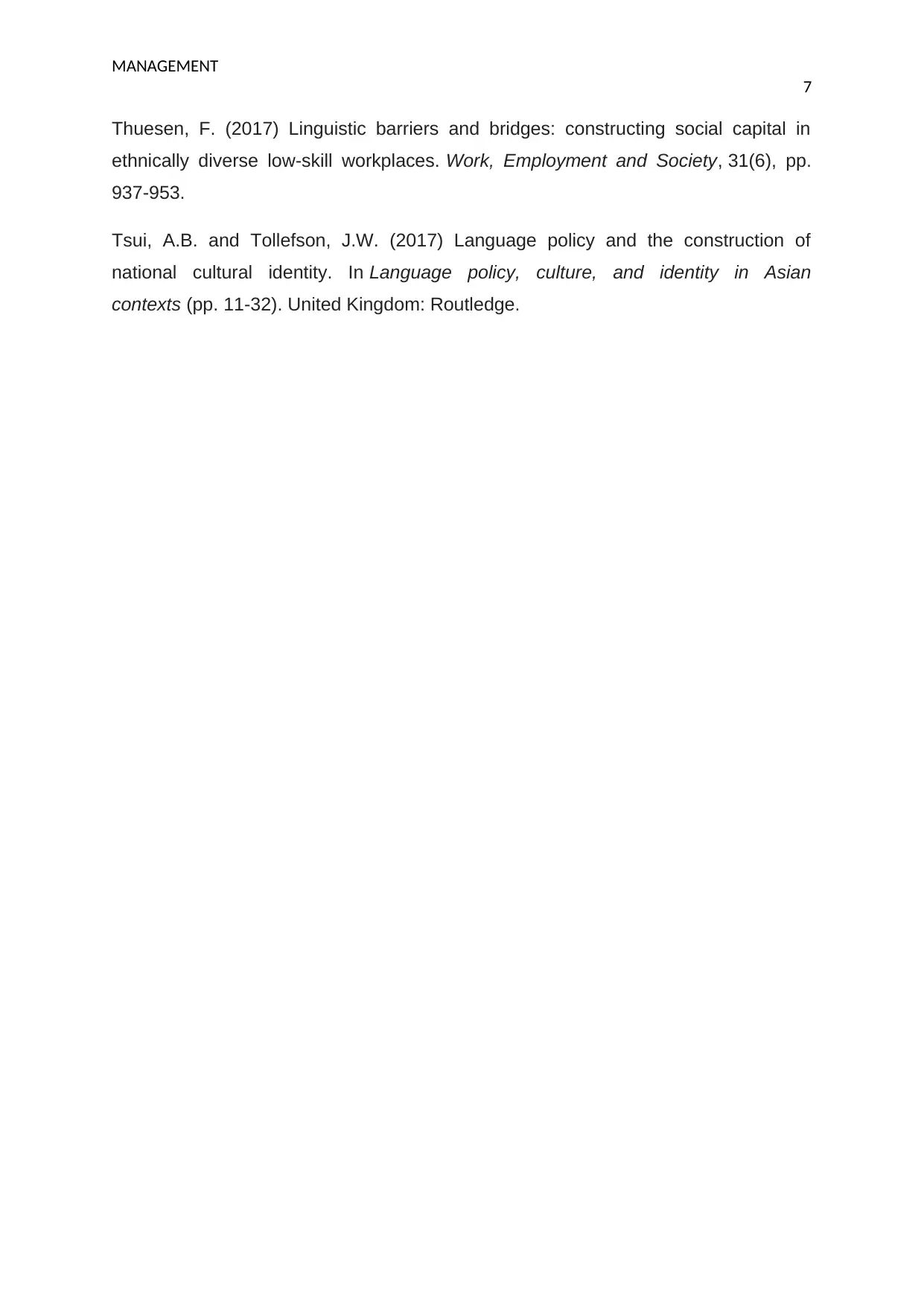
MANAGEMENT
7
Thuesen, F. (2017) Linguistic barriers and bridges: constructing social capital in
ethnically diverse low-skill workplaces. Work, Employment and Society, 31(6), pp.
937-953.
Tsui, A.B. and Tollefson, J.W. (2017) Language policy and the construction of
national cultural identity. In Language policy, culture, and identity in Asian
contexts (pp. 11-32). United Kingdom: Routledge.
7
Thuesen, F. (2017) Linguistic barriers and bridges: constructing social capital in
ethnically diverse low-skill workplaces. Work, Employment and Society, 31(6), pp.
937-953.
Tsui, A.B. and Tollefson, J.W. (2017) Language policy and the construction of
national cultural identity. In Language policy, culture, and identity in Asian
contexts (pp. 11-32). United Kingdom: Routledge.
1 out of 8
Related Documents
Your All-in-One AI-Powered Toolkit for Academic Success.
+13062052269
info@desklib.com
Available 24*7 on WhatsApp / Email
![[object Object]](/_next/static/media/star-bottom.7253800d.svg)
Unlock your academic potential
Copyright © 2020–2025 A2Z Services. All Rights Reserved. Developed and managed by ZUCOL.





